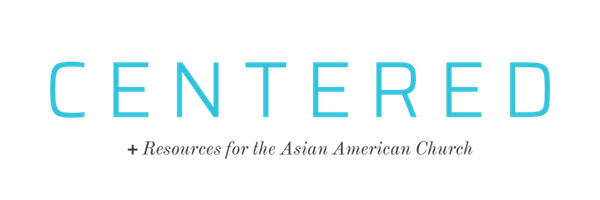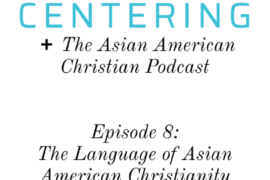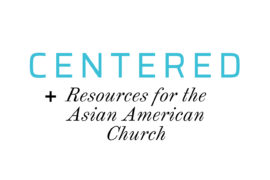[This Advent season, Centered is sharing Asian American Christian reflections on the topic of “Advent and Empire”. Just as the birth of Christ brought peace and deliverance, we hope these entries can speak God’s truth into our times.]
Advent is like a line – but also like an oval.
Let me explain.

Waiting is like a line: it has a beginning and an end. “Your call will be answered in the order received.” We don’t like to wait! But usually the help we need finally does arrive.
The four weeks of Advent end with Christmas. And Christmas itself was the end of very many generations of waiting for the promised Messiah—who finally did arrive as no less than God come in the flesh.
Moreover, Advent also anticipates that Messiah’s return. Someday, he will come again to wrap up human history and make all things new.
So we find ourselves somewhere along a line, one that started with Jesus’ Resurrection and Ascension, and will end with his Second Coming. We’ve been clearly told not to try to guess where we are on that line, but simply to stay growing, faithful, and ready.
We’ve been clearly told not to try to guess where we are, but simply to stay growing, faithful, and ready.
That’s where the oval comes in. In his book, The Wolf Shall Dwell with the Lamb (1993, Chalice Press), Eric H. F. Law sets out what he calls “The Cycle of Gospel Living.” In this cycle, the Christian life revolves around two different focuses: 1. the Cross, and, 2. the Empty Tomb. We need both the Cross and the Empty Tomb to stay growing, faithful, and ready.
An oval is centered on two focal points, each equally important. Here, the Cross, is one focal point: a place of dying, giving up power, and letting go. The other focal point, the Empty Tomb, is a place of empowerment, resurrection, and new life. As Paul puts it, “I want to know Christ and experience the mighty power that raised him from the dead. I want to suffer with him, sharing in his death, so that one way or another I will experience the resurrection from the dead!” (Philippians 3:10-11, NLT).
In the Christian life, we are in constant motion: either going from the Cross to the Empty Tomb, or returning back to the Cross, where the cycle starts anew. Actually, at any given time we may find different parts of our lives simultaneously at different points in the cycle. Perhaps we’re experiencing ministry setbacks, while also growing in prayer and faith, while growing in financial resources, while experiencing health crises, and so forth. (Indeed, the Rev. Law encourages us to deliberately push the cycle along, seeking ways to give away power and resources when we have them; and ways to embrace power and resources when we don’t have them.)
In the Christian life, we are in constant motion: going from the Cross to the Empty Tomb or returning to the Cross, where the cycle starts anew.
We can also view other cycles on a larger scale. In many ways the Asian American church has been on the part of the cycle that moves toward the Empty Tomb, gaining in size, influence, leadership, and resources (like Fuller Seminary’s Asian American Center). When I started seminary there was not one book on Asian American ministry; now there are enough to fill a good sized shelf or two. The particular challenge for the Asian American church is to move toward the Empty Tomb by cultivating our own voices, stories, and presence, rather than being content to assimilate into some fractional share of the majority-culture American church. Meanwhile, many parts of that majority-culture church have been on the path toward the Cross, with long declines in institutional and societal presence (e.g., the dramatic rise of the “Nones,” those individuals who claim no religious affiliation).
American Christianity is generally good at the Empty Tomb part of the cycle. We like it when things are growing, succeeding, and expanding. Indeed, we easily spiritualize such growth as evidence of God’s leading and favor.
The particular challenge for the Asian American church is to… cultivate our own voices, stories, and presence, rather than being content to assimilate into the majority-culture American church.
This is not all bad. There’s a place for American optimism and a reflex towards goals and action. I think, for instance, of the many decades of American leadership and support in modern worldwide Bible translation and literacy efforts. Seeing a clear need, we take it upon ourselves to fill it. We push from the Cross to the Empty Tomb.
But the American church has great difficulty in embracing the part of the cycle that points to the Cross. We don’t like things that are dying, fading, and losing power. That feels like spiritual failure and perhaps a sign of God’s disfavor. I suspect this is true of both more-progressive and more-conservative strands of the American church. Each in its own way has tendencies towards empire-building: each is quite expansively prescriptive, self-sure, and determined to grow and prevail.

I believe the Asian American church has the potential to make a special contribution towards cultivating the way of the Cross. Our lived experiences and cultural heritage make us more ready than the western majority culture to acknowledge and accept hardship and tragedy as inherent parts of life.
I think of Bong Joon-ho’s acclaimed new movie Parasite, with (mild spoiler alert!) its notably bleak view of human nature and modern society. In director Bong’s lens, the lives of both the rich and the poor are shot through with tragedy and struggle. Human relationships are impossibly challenging and generally mutually exploitative. The only happy endings are fantasy and not reality. Back in real life, I think of portions of our South East Asian American communities and their present trauma with deportation perils, and now the aftermath of a mass shooting in Fresno. Hardship and tragedy are never far away.
…the Good News includes both the Empty Tomb and the Cross.
Of course it’s precisely here in the tragedy of the human condition that the Good News of Jesus Christ shines in the darkness! But that Good News includes both the Empty Tomb and the Cross. Christian faith is not a ticket out of the tragedy of the human condition, but rather a way of experiencing that tragedy with a redemptive and eternal sense of hope, meaning, and purpose. I believe the Asian American church is specially positioned to help recover this Cross-ward side of the Christian journey. In poetic fashion, one fruit of our growth may be precisely to help the larger church renew its embrace of Jesus’ suffering and death.
And so, Advent is both a line and an oval, both a journey towards our ultimate hope and a long experience in this life of both death and new life. As we count down the days to Christmas and re-welcome the child in the manger, and as we live our lives day by day awaiting Jesus’ return as the King of kings and Lord of lords, let’s embrace both the Cross and the Empty Tomb as equally essential.



Comments are closed.